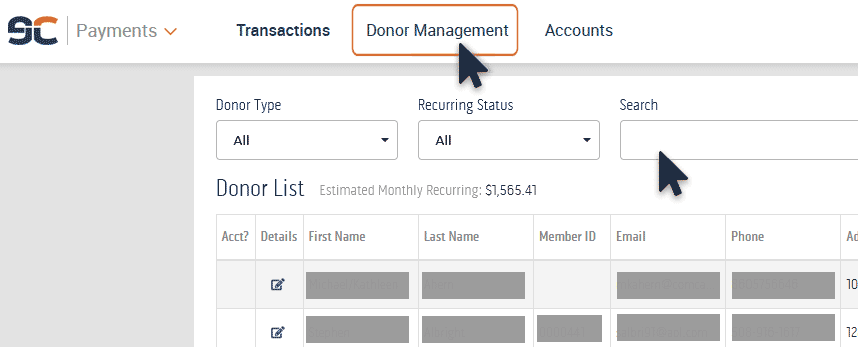Manage recurring transactions in the Donor Management tab
Each time a visitor creates a recurring transaction on your website, a donor account is automatically created in your Payments Center. Click on the Donor Management tab to view, edit, and manage your donor details and transactions.
- 1
-
Log in and access the Payments Center
Log in to your eCatholic website and select Payments from the product selector in the upper left hand corner to open the Payments Center.

Access the Donor Management
Next, click Donor Management to view a list of all donors who have initiated a recurring transaction on your site by filtering for active recurring donors as shown below.

-
3
-
Edit donor details
Once in the Donor Management tab, use the Search field to locate the donor you wish to edit. Once located, click the details icon (located in the Details column, pictured below) to open an individual donor's donor details.

The Donor Details dialog allows you to edit the donor's name, member ID, email address, phone number, and address. From this dialog, you can also add an Admin Note to a donor account for your internal records, export a transaction report, or send the donor an account creation email so they can log in and manage the details of their recurring transaction(s) themselves.

NOTE: Any edited fields in the Donor Details dialog will appear highlighted in blue.
- 3
-
View recurring transactions and transaction history
The Donor Details dialog also lists any recurring transactions associated with that donor, as well as the donor's transaction history (pictured below).

- 4
-
How to edit a recurring transaction
To edit an active recurring transaction, click the details icon (located in the Details column) for a transaction, which will open the Recurring Transaction Details dialog.


In this dialog, you can edit:
- The amount of the recurring transaction
- The frequency of the recurring transaction (Monthly, Weekly, Quarterly, Annually)
- The cycles (i.e., duration) of the recurring transaction (Unlimited, Limited)
- When a recurring transaction is limited, the number in the "Cycle" field is the number of transactions remaining until it stops. E.g. for a weekly transaction with 12 cycles remaining, the transaction will process for each of 12 more weeks; for a monthly transaction, each of 12 more months; etc.
- Once you set cycles to limited, you cannot change back to unlimited.
- The status of the recurring transaction (Active, Paused) *Paused is the same as Stopped. If you need to stop a transaction, switch the status to Paused.
- The date of next charge
- Cancel the recurring transaction by clicking the Cancel Recurring Transaction button.
- The expiration date of the credit card being charged
- The account or subaccount with which the recurring transaction is associated
NOTE: The transaction history visible on this screen is specific to this particular recurring transaction (if a donor has multiple recurring transactions in their account). You can toggle between viewing transactions from This Year or Last Year, as well as pull an export of the donor's transactions.
- 5
-
How to reactivate a failed recurring transaction
In most cases, your donor is the only one who can reactivate their failed transaction, since only donors can update sensitive payment data. However, a payments admin can change the credit card expiration date. (Watch video below for detailed instructions.)
We've added some additional helpful hints to the recurring transaction details screen since this video was recorded, but the process for reactivating a failed transaction hasn't changed!
After updating the transaction details to correct any issue, click the green Reactivate button to save the changes and set the transaction status back to Active.
If any payments have been missed while the transaction was inactive, you can also choose to process a one-time charge to make up this missed payment.
TIP: If the reason for the transaction failure is known, it is shown next to the transaction's status. You can use this information to determine what needs to be corrected in the transaction details. If no detail is given, most often the donor will need to follow up with their bank to get more information. 
If your donor has difficulty logging into their account to make changes to their payment information, failed recurring transactions will include a handy link in the recurring details to email them a one-time login link. This will immediately get the donor into their account to make the necessary adjustments and reactivate their transaction.
- 6
-
How to transfer a recurring transaction to another donor
You can also transfer a recurring transaction to another donor within the Recurring Transaction Details dialog by using the transfer button (pictured below).

Once you click the button, you will be prompted to select a new donor for the recurring transaction. Select a donor from the list of suggested best matches or search for a specific donor.

NOTE: By default, donors sharing the same first name, last name, and email will be automatically merged. Donors that do not have all three fields matching can still be manually merged as needed. When transferring a recurring transaction to another donor, it will delete the old (i.e. original) donor for the transaction. If you wish to not delete the original donor, locate the "Also, delete the old donor for the transaction" check box and make sure it is not selected.









